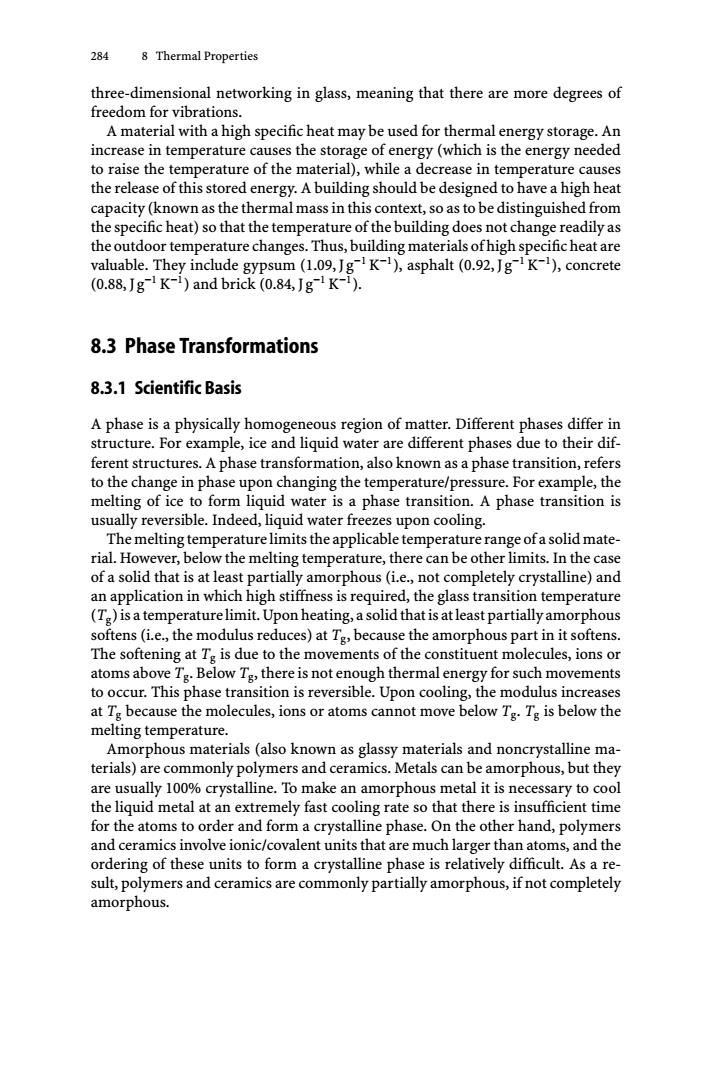正在加载图片...

284 8 Thermal Properties three-dimensional networking in glass,meaning that there are more degrees of freedom for vibrations. A material with a high specific heat may be used for thermal energy storage.An increase in temperature causes the storage of energy(which is the energy needed to raise the temperature of the material),while a decrease in temperature causes the release of this stored energy.A building should be designed to have a high heat capacity(known as the thermal mass in this context,so as to be distinguished from the specific heat)so that the temperature of the building does not change readily as the outdoor temperature changes.Thus,building materials ofhigh specific heat are valuable.They include gypsum(1.09,Jg-K-1),asphalt(0.92,Jg-K-),concrete (0.88,Jg-K-)and brick (0.84,Jg-K). 8.3 Phase Transformations 8.3.1 Scientific Basis A phase is a physically homogeneous region of matter.Different phases differ in structure.For example,ice and liquid water are different phases due to their dif- ferent structures.A phase transformation,also known as a phase transition,refers to the change in phase upon changing the temperature/pressure.For example,the melting of ice to form liquid water is a phase transition.A phase transition is usually reversible.Indeed,liquid water freezes upon cooling. The melting temperature limits the applicable temperature range of a solid mate- rial.However,below the melting temperature,there can be other limits.In the case of a solid that is at least partially amorphous(i.e.,not completely crystalline)and an application in which high stiffness is required,the glass transition temperature (Ts)is a temperature limit.Upon heating,a solid that is at least partially amorphous softens(i.e.,the modulus reduces)at Tg,because the amorphous part in it softens. The softening at Te is due to the movements of the constituent molecules,ions or atoms above Tg.Below Tg,there is not enough thermal energy for such movements to occur.This phase transition is reversible.Upon cooling,the modulus increases at Tg because the molecules,ions or atoms cannot move below Tg.Tg is below the melting temperature. Amorphous materials(also known as glassy materials and noncrystalline ma- terials)are commonly polymers and ceramics.Metals can be amorphous,but they are usually 100%crystalline.To make an amorphous metal it is necessary to cool the liquid metal at an extremely fast cooling rate so that there is insufficient time for the atoms to order and form a crystalline phase.On the other hand,polymers and ceramics involve ionic/covalent units that are much larger than atoms,and the ordering of these units to form a crystalline phase is relatively difficult.As a re- sult,polymers and ceramics are commonly partially amorphous,if not completely amorphous.284 8 Thermal Properties three-dimensional networking in glass, meaning that there are more degrees of freedom for vibrations. A material with a high specific heat may be used for thermal energy storage. An increase in temperature causes the storage of energy (which is the energy needed to raise the temperature of the material), while a decrease in temperature causes the release of this stored energy. A building should be designed to have a high heat capacity (known as the thermal mass in this context, so as to be distinguished from the specific heat) so that the temperature of the building does not change readily as the outdoor temperature changes. Thus, building materials of high specific heat are valuable. They include gypsum (1.09, Jg−1 K−1), asphalt (0.92, Jg−1 K−1), concrete (0.88, Jg−1 K−1) and brick (0.84, Jg−1 K−1). 8.3 Phase Transformations 8.3.1 Scientific Basis A phase is a physically homogeneous region of matter. Different phases differ in structure. For example, ice and liquid water are different phases due to their different structures. A phase transformation, also known as a phase transition, refers to the change in phase upon changing the temperature/pressure. For example, the melting of ice to form liquid water is a phase transition. A phase transition is usually reversible. Indeed, liquid water freezes upon cooling. The melting temperature limits the applicable temperature range of a solid material. However, below the melting temperature, there can be other limits. In the case of a solid that is at least partially amorphous (i.e., not completely crystalline) and an application in which high stiffness is required, the glass transition temperature (Tg) is a temperature limit. Upon heating, a solid that is at least partially amorphous softens (i.e., the modulus reduces) at Tg, because the amorphous part in it softens. The softening at Tg is due to the movements of the constituent molecules, ions or atoms above Tg. Below Tg, there is not enough thermal energy for such movements to occur. This phase transition is reversible. Upon cooling, the modulus increases at Tg because the molecules, ions or atoms cannot move below Tg. Tg is below the melting temperature. Amorphous materials (also known as glassy materials and noncrystalline materials) are commonly polymers and ceramics. Metals can be amorphous, but they are usually 100% crystalline. To make an amorphous metal it is necessary to cool the liquid metal at an extremely fast cooling rate so that there is insufficient time for the atoms to order and form a crystalline phase. On the other hand, polymers and ceramics involve ionic/covalent units that are much larger than atoms, and the ordering of these units to form a crystalline phase is relatively difficult. As a result, polymers and ceramics are commonly partially amorphous, if not completely amorphous